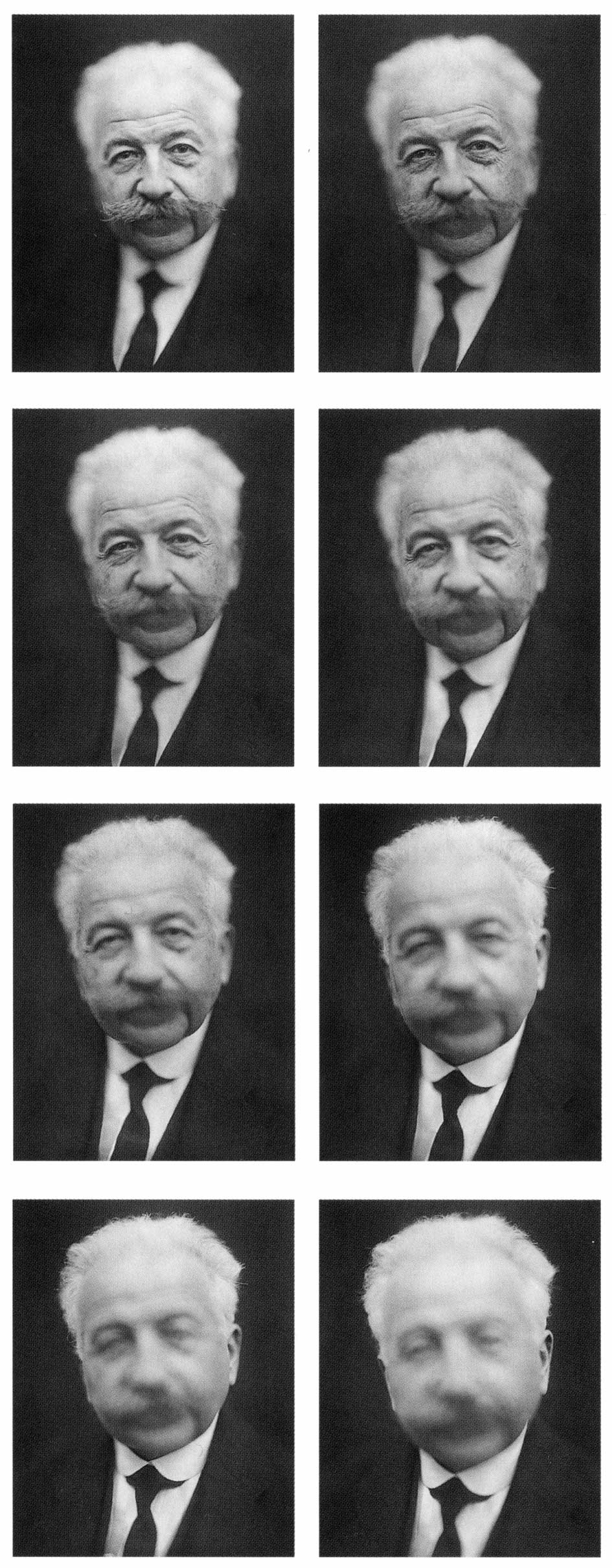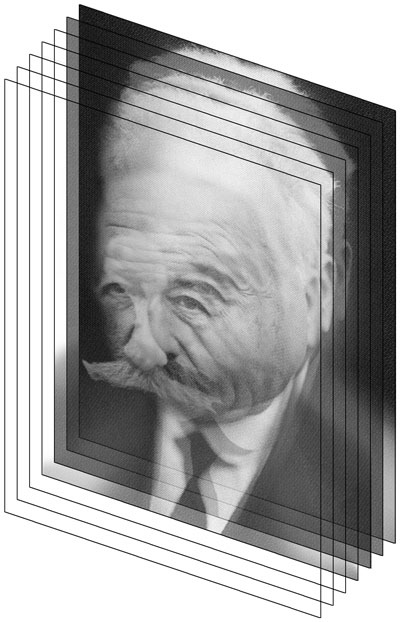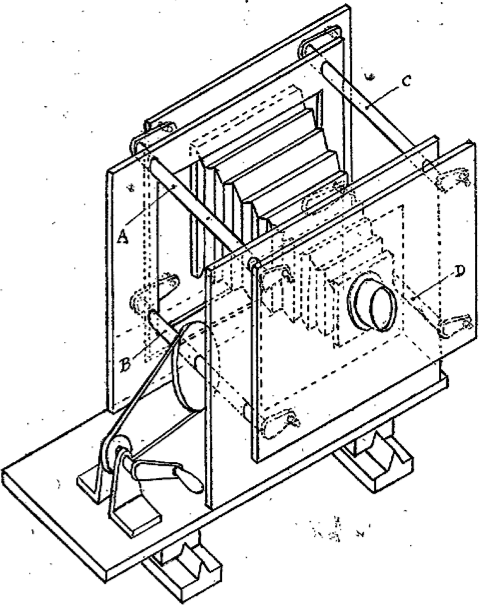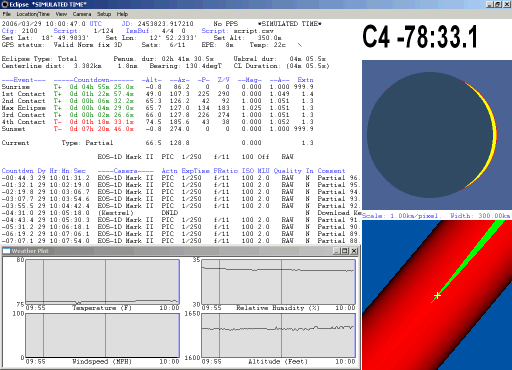Abstract:
Research and development of a custom microprocessor-based digital camera focus controller in the style of Louis Lumière’s 1920s-era layered photographic technology, photostereosynthesis.
Keywords:
Photostererosynthesis, photostéréosynthèse, Lumière, film history, cinema, photography history, media art history, new media, media archaeology, digital imaging, 3D, microcontroller, robotics, software, visualization, volumetric imaging.
Project URL:
<
http://www.conceptlab.com/photostereosynthesis
>
Goals & Aims of Research
This research project is focused on the construction of a custom microcontroller-based digital single lens reflex (SLR) camera focal control system, with the intentions of re-creating "photosterosynthesis": a photography-based 3D imaging technique invented by Louis Lumière in Paris, France in the first two decades of the 1900s. This imaging technology produces dimensionally deep and multi-layered images, and has the ability to be considerably explored and expanded with contemporary lenses, digital cameras, and software.
The purpose of this project is to develop contemporary camera control software for the production of large format digital photostereosynthesis images. At a later date, these images will be used as components in a large-scale media art installation, proposed to be exhibited in 2010 or 2011.
On a historical and theoretical level, this project excavates a lost imaging technology developed by the co-inventor of contemporary cinema, Louis Lumière. Historiographically, this project proposes that Lumière's primary interest in the invention of cinema was the exploration of depth, not movement. In other words, the dimensionality of photostereosynthesis can be used to speculate whether Louis Lumière's goals in the invention of cinema were to primarily capture a sense of three dimensional space as opposed to a moving two dimensional image.
Beyond artistic and historiographical applications, this technology has the potential to extract three dimensional data from a consumer-level digital SLR camera with a single lens in a fixed position in a relatively short period of time (under one second).
As an overview, this proposal:
• provides a historical context for this project
• outlines a detailed plan for the completion of this research project
• explains the technical mechanics of the proposed system
• describes the importance of this research historically, artistically, and scientifically.
Detailed Description of Activity - Historical Context
Louis and Auguste Lumière are best known as inventors of the cinematographic projector and the first publicly screened film to a paying audience:
La Sortie de l'Usine Lumière à Lyon
(1895), a 17 meter long one-shot documentary film that at 16 frames per second, runs for a duration of 50 seconds.
Film historians widely consider the Lumière brothers to be the inventors of contemporary cinema.
Figure 2. Lumière Brothers, La Sortie de l'Usine Lumière à Lyon "Two Horses" version, (1895). (Also available as a 1.9M QuickTime file.)
Through his life, Louis Lumière continued to investigate different imaging technologies, and in the early 1900s invented photostereosynthesis: a process in which a series of still photographs are shot at extremely small depths of field (wide open aperture) at incrementally increasing focal lengths (30cm, 31cm, 32cm, 33cm, 34cm, for example). As a result of the wide aperture and custom camera, each image has approximately only 1cm of the depth of the scene in sharp focus.

Figure 3a. Louis Lumière,
Portraits of Auguste Lumière, stages in ‘photostéréosynthèse’,
c. 1920
Each individual exposure is printed as a transparent positive on glass and stacked to produce a composite 3D photo with the subject "entombed" in a translucent image several centimeters thick. The resulting composite image is somewhat similar to a hologram or an autostereoscopic or volumetric image.

Figure 3b. Diagram of orthographic view of photostereosynthesis layers, using Louis Lumière's
Portraits of Auguste Lumière, stages in ‘photostéréosynthèse’.
Traditionally, this photographic technology was only used for portraiture, and used a large format camera built by Lumière that mechanically narrowed the image's depth of focus. Images were difficult to produce and print, demanded that the model sit still for a long period of time between camera adjustments/exposures, and required a custom camera. Although photostereosynthesis was an aesthetically beautiful and innovative imaging technology, it failed to succeeded commercially. Only twelve examples of photostereosynthesis images have survived today, and the custom camera has been destroyed. As part of the background research for this project, an original photostereosynthesis image has been viewed in the archives of the Getty Research Institute in Los Angles, California in 2007.

Figure 4a. Photograph of the custom camera used in photostereosynthesis, in Raymond Lecuyer,
Histoire de la Photographie,
Baschet et Cie, Prais, 1945, p. 289.

Figure 4b. Diagram of the custom camera used in photostereosynthesis, in Louis Lumière,
Représentation photographique d'un solide dans l'espace. Photo-stéréo-synthèse,
Académie des Sciences, November 8th 1920, p. 895. For background on the original camera system, see the source document: Représentation photographique d'un solide dans l'espace (452K PDF, in French).
PHASE 1 - Detailed Description of Activity - Camera Technology Research & Development
Current digital SLR camera systems have the capability to overcome many of the obstacles involved in the original production of photostereosynthesis images. Fast exposure framerates, high resolution digital sensors, computerized focus control software, and extremely large aperture lenses combine to provide a camera system that can shoot a photostereosynthesis series of images in under one second. Although this proposal primarily deals with the artistic and historical applications of this technology, it is proposed that updating and revising this imaging technology also has significant potential to impact visualization research.
At its core, this project strives to construct custom camera control software to facilitate the production of photostereosynthesis images on a standard, unmodified 35mm digital SLR camera. The deliverable of this project will be an easy to use camera system to acquire multiple exposures at a small depth of focus at incremental distances.
Research Stage 1A:
Camera Acquisition
To initiate this project, a digital camera and lens needs to be acquired through rental or purchase. The camera system needs to have: 1. Robust camera control software with a USB computer interface, 2. Rapid motor/auto focus lens with very large aperture, 3. A high-speed burst mode to shoot multiple images quickly, and 4. A high resolution digital sensor to facilitate the printing of large format images.
The best camera for this job is the
Canon EOS-1Ds Mark III body, with a Canon EF 50mm f/1.2L USM lens. This camera system has a robust software development environment, has an f/1.2 motor focus lens, and can shoot 21.1 RAW megapixel images at five frames per second.


Figure 5. Canon EOS-1Ds Mark III body, with a Canon EF 50mm f/1.2L USM lens.
Research Stage 1B:
Computer-Based Camera Control
Canon EOS cameras have an excellent software development environment: a computer environment that helps people develop their own camera control software. This has helped produce numerous software packages to automate camera focal control, many of which are available free of charge.

Figure 6. A screenshot of Eclipse, a freeware software system designed by Fred Bruenjes to design Canon EOS camera control scripts.
To begin this project, a Canon EOS camera and lens will be purchased or rented, and existing freeware camera control software - like Eclipse by Fred Bruenjes - will be used to develop a laptop-based camera control system for the production of photostereosynthesis images. This software allows users to develop scripts to control focus and shutter settings via a USB cable connected between the camera and a computer. In the case of this project, a simple script will be developed to take photos at incremental focal lengths: 30cm, 31cm, 32cm, 33cm, and 34cm for example.
Research Stage 1C:
Microcontroller-Based Camera Control
Once a cabled laptop system is functioning, the development of a small microcontroller-based camera controller will begin. The purpose of this system will be to not have to carry a laptop during all photo shoots. Instead, the same camera control information can be transmitted with a small device that plugs directly into the camera’s USB port.

Figure 7. Parallax’s PropStick USB Microcontroller. See
http://www.parallax.com/detail.asp?product_id=32210
This camera controller will be developed using Parallax's PropStick USB to send focus control data to the camera. This microprocessor is a good choice because it is compact, easy to program, has a built-in USB interface, and is relatively inexpensive ($79.95). In addition, I have considerable experience programming Parallax microcontrollers (see previous projects, including Cockroach Controlled Mobile Robot.)
PHASE 1 - Importance of Research
This project is important because of its historical significance, its technical enabling of innovative artistic production by Garnet Hertz, and its future benefits as an imaging technology for aquiring 3D data from a single-lens consumer SLR camera.
As a historical intervention, this project takes a largely forgotten media technology, revisits it, and extends it as a viable technique to capture volumetric images. As a statement, this system proposes that Lumière’s imaging technology is still a valid and useful technique for capturing a representation of an object or space. With contemporary speeds of exposure and automated and motorized lenses, photostereosynthesis has the ability to continue and expand a branch of history that was largely forgotten in the 1920s. In the process, this project highlights the important but often academically neglected perspective that Lumière's career and the invention of cinema was not only an exploration into the moving image, but primarily the development of a “deep” dimensional image.
Secondly, the development of this camera system is required for the artistic development of a large scale gallery project by Garnet Hertz, envisioned to be exhibited in 2010 or 2011. Professionally, this project marks a significant step for Hertz moving beyond his recent work that primarily explores the relationship between biological organisms and technology that have been exhibited at Ars Electronica, Siggraph, InterAccess, in Ireland, the Netherlands, and through the United States and Canada. With this project, technological development exists primarily as a background to the production of an aesthetic, historical and conceptual gallery object. This shift marks a significant point of growth for Hertz's career: technology still plays a significant role, but it has taken a subservient role to the aesthetic object.
Lastly, this camera technique has the advantage of capturing unique 3D images with a single lens consumer camera in a fixed position in a short period of time. In comparison to 3D scanners, robotic cameras, and other technologies, this system is relatively straightforward and inexpensive. In addition to the 3D attributes of photostereosynthesis, the technology is significant for 2D imaging as well: it has the potential to bring advancements to digital imaging in a similar manner to the technique of High Dynamic Rance (HDR) images created from multiple digital frames. While HDR utilizes multiple frames of the same scene at varying exposures, photostereosynthesis utilizes multiple frames of varying focal distances. With HDR, an image with increased dynamic range results; with photostereosynthesis a 2D image with increased focus would result. Both 2D and 3D applications of photostereosynthesis have potential advantages for visualization research and image processing.
In summary, this project is relevant to a number of fields: history of cinema and photography, artistic production, and imaging research. It represents a unique blend of historical, aesthetic and scientific innovation.
PHASES 2 & 3 - Artistic Production & Output/Display
At this point, only Phase 1 (Camera Technology Research & Development) is proposed. Phases 2 (Artistic Production) and Phases 3 (Output/Display) will be outlined in a subsequent proposal after the camera system is built.
q